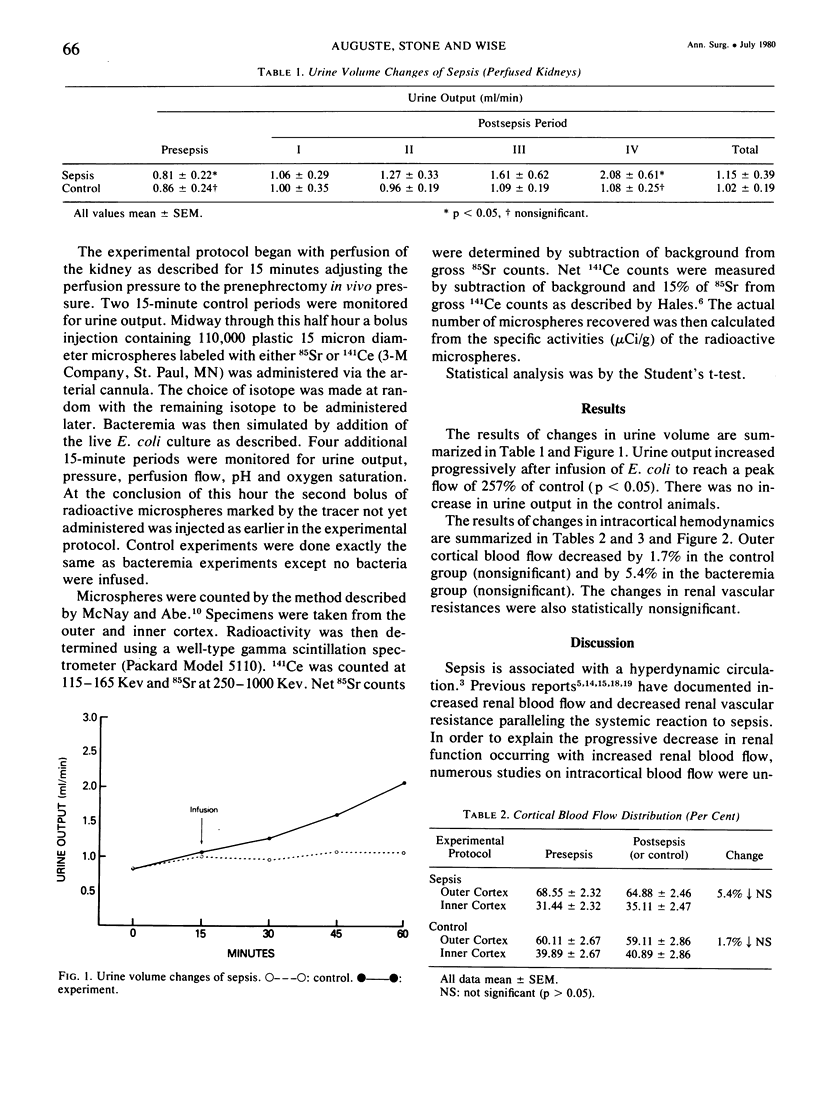Abstract
The renal response to sepsis results in increased renal blood flow, decreased renal vascular resistance, polyuric renal failure and a change in intracortical renal blood distribution. Prior reports used whole animal preparations, where the effects of sepsis on other organs may have led to systemic vasoactive changes altering the experimental model. To elucidate the direct effect of gram negative bacteremia on the kidney, intracortical hemodynamics and urinary flow were investigated using isolated canine kidneys perfused with a nonpulsatile pump oxygenator primed with modified dog plasma. Bacteremia was produced by 2.5 x 10(11) live Escherichia coli organisms infused directly into the perfusate. Intracortical blood flow distribution was measured by radioactive microsphere trapping using 15 microns diameter plastic radioactive microspheres. Urine flow increased 157% (p less than 0.05) following E. coli bacteremia while intracortical blood distribution was unchanged. The polyuric renal failure of sepsis is therefore, a direct result of bacteremia and not secondary to a change in intracortical flow as previously reported. The changes in intracortical blood distribution reported previously in sepsis using intact animal models probably reflect the renal response to release of vasoactive compounds originating in other organs rather than an intrinsic renal reaction to bacteremia.
Full text
PDF



Selected References
These references are in PubMed. This may not be the complete list of references from this article.
- BELZER F. O., PARK H. Y., VETTO R. M. FACTORS INFLUENCING RENAL BLOOD FLOW DURING ISOLATED PERFUSION. Surg Forum. 1964;15:222–224. [PubMed] [Google Scholar]
- Bair E. D., Borden T. A., Peter E. T. Normothermic ex vivo renal perfusion. Urology. 1974 Dec;4(6):734–736. doi: 10.1016/0090-4295(74)90261-1. [DOI] [PubMed] [Google Scholar]
- Clowes G. H., Jr, O'Donnell T. F., Jr, Ryan N. T., Blackburn G. L. Energy metabolism in sepsis: treatment based on different patterns in shock and high output stage. Ann Surg. 1974 May;179(5):684–696. doi: 10.1097/00000658-197405000-00023. [DOI] [PMC free article] [PubMed] [Google Scholar]
- Cortez A., Zito J., Lucas C. E., Gerrick S. J. Mechanism of inappropriate polyuria in septic patients. Arch Surg. 1977 Apr;112(4):471–476. doi: 10.1001/archsurg.1977.01370040123019. [DOI] [PubMed] [Google Scholar]
- Cronenwett J. L., Lindenauer S. M. Distribution of intrarenal blood flow during bacterial sepsis. J Surg Res. 1978 Mar;24(3):132–141. doi: 10.1016/0022-4804(78)90165-8. [DOI] [PubMed] [Google Scholar]
- Hermreck A. S., Berg R. A., Ruhlen J. R., MacArthur R. I. Renal response in sepsis. Arch Surg. 1973 Aug;107(2):169–175. doi: 10.1001/archsurg.1973.01350200043012. [DOI] [PubMed] [Google Scholar]
- Hinshaw L. B., Benjamin B., Holmes D. D., Beller B., Archer L. T., Coalson J. J., Whitsett T. Responses of the baboon to live Escherichia coli organisms and endotoxin. Surg Gynecol Obstet. 1977 Jul;145(1):1–11. [PubMed] [Google Scholar]
- Larsson C., Anggård E. Increased juxtamedullary blood flow on stimulation of intrarenal prostaglandin biosynthesis. Eur J Pharmacol. 1974 Mar;25(3):326–334. doi: 10.1016/0014-2999(74)90263-5. [DOI] [PubMed] [Google Scholar]
- McNay J. L., Abe Y. Redistribution of cortical blood flow during renal vasodilatation in dogs. Circ Res. 1970 Dec;27(6):1023–1032. doi: 10.1161/01.res.27.6.1023. [DOI] [PubMed] [Google Scholar]
- Myrvold H. E., Brandberg A., Lindquist O., Busch C., Lewis D. H. The role of platelets and fibrinogen in experimental septic shock. Acta Chir Scand. 1977;143(3):131–137. [PubMed] [Google Scholar]
- O'Donnell T. F., Jr, Clowes G. H., Jr, Talamo R. C., Colman R. W. Kinin activation in the blood of patients with sepsis. Surg Gynecol Obstet. 1976 Oct;143(4):539–545. [PubMed] [Google Scholar]
- Pegg D. E., Green C. J. Renal preservation by hypothermic perfusion. III. The lack of influence of pulsatile flow. Cryobiology. 1976 Apr;13(2):161–167. doi: 10.1016/0011-2240(76)90128-0. [DOI] [PubMed] [Google Scholar]
- Ravikant T., Lucas C. E. Renal blood flow distribution in septic hyperdynamic pigs. J Surg Res. 1977 Mar;22(3):294–298. doi: 10.1016/0022-4804(77)90146-9. [DOI] [PubMed] [Google Scholar]
- Rector F., Goyal S., Rosenberg I. K., Lucas C. E. Sepsis: a mechanism for vasodilatation in the kidney. Ann Surg. 1973 Aug;178(2):222–226. doi: 10.1097/00000658-197308000-00021. [DOI] [PMC free article] [PubMed] [Google Scholar]
- Schumer W., Erve P. R., Obernolte R. P. Mechanisms of steroid protection in septic shock. Surgery. 1972 Jul;72(1):119–125. [PubMed] [Google Scholar]
- Vargish T., Levin R., Cotton J., Cukingnan R. A., Boyd J. C., Stahl W. M. Changes in renal function and intrarenal blood flow. Ann Surg. 1973 Oct;178(4):496–502. doi: 10.1097/00000658-197310000-00012. [DOI] [PMC free article] [PubMed] [Google Scholar]


